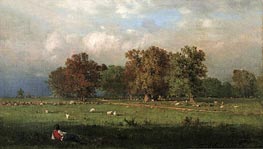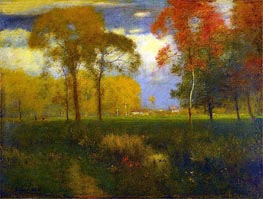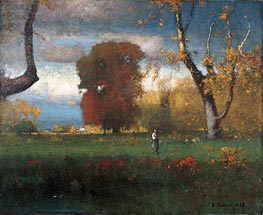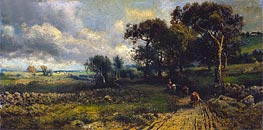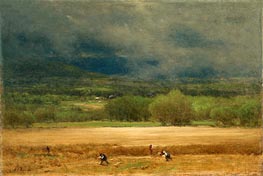Landscape Painting Reproductions - Page 167
Landscape painting is a genre of art that depicts outdoor scenes, such as mountains, forests, rivers, and gardens. The history of landscape painting dates back to ancient times, with examples from ancient Egyptian, Greek, and Roman art. During the Middle Ages, landscape paintings were mainly used as backgrounds for religious scenes, and it was not until the Renaissance that landscape painting emerged as a separate genre.
During the Renaissance, artists started to focus more on the natural world and began to experiment with perspective, light and shadow, and atmospheric effects in their landscapes. This period also saw the rise of topographical painting, which depicted accurate views of specific locations. During this time, artists such as Leonardo da Vinci and Albrecht Dürer produced iconic landscape paintings.
The 17th century Dutch Golden Age saw a trend towards landscapes that were more genre-like and less topographical, with scenes of everyday life and landscapes with rolling hills, waterways, and windmills. This period is also known for the development of the "Dutch light" style, which was characterized by a luminous, highly transparent quality of light and a preference for sunny skies. Painters such as Jan van Goyen and Jacob van Ruisdael became renowned for their realistic landscapes.
In the 18th and 19th centuries, Romanticism and the interest in the Sublime in art and literature led to a focus on dramatic, awe-inspiring landscapes. Painters such as J.M.W. Turner and Caspar David Friedrich used dramatic light, color, and form to evoke a sense of awe and drama in their landscapes.
The Impressionist movement of the late 19th century was characterized by its loose brushwork, light color palette, and emphasis on capturing the fleeting effects of light and atmosphere. Impressionist landscapes, such as those by Claude Monet and Pierre-Auguste Renoir, often depicted modern life, with leisurely scenes of parks, gardens, and the countryside.
Throughout the 20th century, landscape painting continued to evolve and diversify, with many artists pushing the boundaries of the genre through new styles and techniques. Some notable examples include the abstract landscapes of artists such as Mark Rothko and Joan Mitchell, and the photorealistic landscapes of Richard Estes and Ralph Goings.
Overall, landscape painting has a rich and varied history, reflecting the changing attitudes and perspectives of different cultures and time periods.
During the Renaissance, artists started to focus more on the natural world and began to experiment with perspective, light and shadow, and atmospheric effects in their landscapes. This period also saw the rise of topographical painting, which depicted accurate views of specific locations. During this time, artists such as Leonardo da Vinci and Albrecht Dürer produced iconic landscape paintings.
The 17th century Dutch Golden Age saw a trend towards landscapes that were more genre-like and less topographical, with scenes of everyday life and landscapes with rolling hills, waterways, and windmills. This period is also known for the development of the "Dutch light" style, which was characterized by a luminous, highly transparent quality of light and a preference for sunny skies. Painters such as Jan van Goyen and Jacob van Ruisdael became renowned for their realistic landscapes.
In the 18th and 19th centuries, Romanticism and the interest in the Sublime in art and literature led to a focus on dramatic, awe-inspiring landscapes. Painters such as J.M.W. Turner and Caspar David Friedrich used dramatic light, color, and form to evoke a sense of awe and drama in their landscapes.
The Impressionist movement of the late 19th century was characterized by its loose brushwork, light color palette, and emphasis on capturing the fleeting effects of light and atmosphere. Impressionist landscapes, such as those by Claude Monet and Pierre-Auguste Renoir, often depicted modern life, with leisurely scenes of parks, gardens, and the countryside.
Throughout the 20th century, landscape painting continued to evolve and diversify, with many artists pushing the boundaries of the genre through new styles and techniques. Some notable examples include the abstract landscapes of artists such as Mark Rothko and Joan Mitchell, and the photorealistic landscapes of Richard Estes and Ralph Goings.
Overall, landscape painting has a rich and varied history, reflecting the changing attitudes and perspectives of different cultures and time periods.
page 167 of 275
SKU: ING-9192
George Inness
Original Size: 36.8 x 54.6 cm
Philadelphia Museum of Art Pennsylvania USA
George Inness
Original Size: 36.8 x 54.6 cm
Philadelphia Museum of Art Pennsylvania USA
SKU: ING-9191
George Inness
Original Size: 68.9 x 56.2 cm
Pennsylvania Academy of the Fine Arts Philadelphia USA
George Inness
Original Size: 68.9 x 56.2 cm
Pennsylvania Academy of the Fine Arts Philadelphia USA
SKU: ING-9190
George Inness
Original Size: 77.4 x 114.3 cm
Minneapolis Institute of Arts Minnesota USA
George Inness
Original Size: 77.4 x 114.3 cm
Minneapolis Institute of Arts Minnesota USA
SKU: ING-9189
George Inness
Original Size: 66.7 x 91.5 cm
Fogg Art Museum at Harvard University Massachusetts USA
George Inness
Original Size: 66.7 x 91.5 cm
Fogg Art Museum at Harvard University Massachusetts USA
SKU: ING-9188
George Inness
Original Size: 22.7 x 30.4 cm
Fogg Art Museum at Harvard University Massachusetts USA
George Inness
Original Size: 22.7 x 30.4 cm
Fogg Art Museum at Harvard University Massachusetts USA
SKU: ING-9187
George Inness
Original Size: 76.2 x 114.3 cm
Dallas Museum of Art Texas USA
George Inness
Original Size: 76.2 x 114.3 cm
Dallas Museum of Art Texas USA
SKU: ING-9186
George Inness
Original Size: 76.2 x 113 cm
Dallas Museum of Art Texas USA
George Inness
Original Size: 76.2 x 113 cm
Dallas Museum of Art Texas USA
SKU: ING-9185
George Inness
Original Size: 76.5 x 114.9 cm
Brooklyn Museum of Art New York USA
George Inness
Original Size: 76.5 x 114.9 cm
Brooklyn Museum of Art New York USA
SKU: ING-9184
George Inness
Original Size: 51.5 x 76.5 cm
Brooklyn Museum of Art New York USA
George Inness
Original Size: 51.5 x 76.5 cm
Brooklyn Museum of Art New York USA
SKU: ING-9183
George Inness
Original Size: 71.8 x 122 cm
Brooklyn Museum of Art New York USA
George Inness
Original Size: 71.8 x 122 cm
Brooklyn Museum of Art New York USA
SKU: ING-9182
George Inness
Original Size: 56 x 91.8 cm
Brooklyn Museum of Art New York USA
George Inness
Original Size: 56 x 91.8 cm
Brooklyn Museum of Art New York USA
SKU: ING-9181
George Inness
Original Size: 39.3 x 67.3 cm
Cleveland Museum of Art Ohio USA
George Inness
Original Size: 39.3 x 67.3 cm
Cleveland Museum of Art Ohio USA
SKU: ING-9180
George Inness
Original Size: 81 x 106 cm
Cleveland Museum of Art Ohio USA
George Inness
Original Size: 81 x 106 cm
Cleveland Museum of Art Ohio USA
SKU: ING-9179
George Inness
Original Size: 56.2 x 70 cm
Cleveland Museum of Art Ohio USA
George Inness
Original Size: 56.2 x 70 cm
Cleveland Museum of Art Ohio USA
SKU: ING-9178
George Inness
Original Size: 25.5 x 51 cm
Cleveland Museum of Art Ohio USA
George Inness
Original Size: 25.5 x 51 cm
Cleveland Museum of Art Ohio USA
SKU: ING-9177
George Inness
Original Size: 50.8 x 76 cm
Cleveland Museum of Art Ohio USA
George Inness
Original Size: 50.8 x 76 cm
Cleveland Museum of Art Ohio USA
SKU: ING-9176
George Inness
Original Size: 73.8 x 113 cm
Cleveland Museum of Art Ohio USA
George Inness
Original Size: 73.8 x 113 cm
Cleveland Museum of Art Ohio USA
SKU: ING-9175
George Inness
Original Size: 30.2 x 22.2 cm
Cleveland Museum of Art Ohio USA
George Inness
Original Size: 30.2 x 22.2 cm
Cleveland Museum of Art Ohio USA
SKU: ING-9174
George Inness
Original Size: 56 x 77.5 cm
Cleveland Museum of Art Ohio USA
George Inness
Original Size: 56 x 77.5 cm
Cleveland Museum of Art Ohio USA
SKU: ING-9173
George Inness
Original Size: 56.5 x 76.8 cm
Cleveland Museum of Art Ohio USA
George Inness
Original Size: 56.5 x 76.8 cm
Cleveland Museum of Art Ohio USA
SKU: ING-9172
George Inness
Original Size: 76.3 x 114.5 cm
Brooklyn Museum of Art New York USA
George Inness
Original Size: 76.3 x 114.5 cm
Brooklyn Museum of Art New York USA
SKU: ING-9171
George Inness
Original Size: 40.6 x 60.9 cm
Bowdoin College Museum of Art Maine USA
George Inness
Original Size: 40.6 x 60.9 cm
Bowdoin College Museum of Art Maine USA
SKU: ING-9170
George Inness
Original Size: 61 x 91.4 cm
Ball State University Museum of Art Indiana USA
George Inness
Original Size: 61 x 91.4 cm
Ball State University Museum of Art Indiana USA
SKU: ING-9169
George Inness
Original Size: 90.5 x 138.5 cm
National Gallery London United Kingdom
George Inness
Original Size: 90.5 x 138.5 cm
National Gallery London United Kingdom





